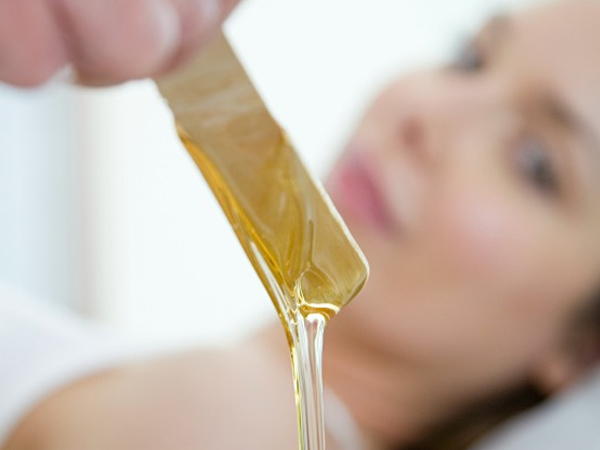If you think STI’s spread through waxing are an urban myth, think again…

It’s the stuff every beauty therapist has heard in whispered murmurs told over a torch around a campfire; horror stories thought to be but urban legends of the beauty world.
But when New York journalist Maddie Rubin wrote about her experience contracting molluscum contagiosum, a skin infection and STI spread through skin-to-skin contact, (typically during sex) at a routine Brazilian wax, the issue of waxing hygiene – and the very real danger of ignoring it – was thrust into the spotlight.
In her candid recount of what Rubin described as an ‘nightmare’ waxing experience, the beauty editor recalls how a painful Brazilian turned into a serious health condition.
“About a month after I got a particularly bloody, painful Brazilian wax from an upscale salon in Manhattan, I noticed little bumps on my bikini line and vulva area. Two of them were in a little cluster, and a few others were more sparse. They basically looked like shiny bumps with a dimple in the middles and a waxy white core.”
After panicking she may have developed a skin infection, Rubin sought the advice of a professional dermatologist.
Peer-reviewed medical journal, JAMA Dermatology, found that waxing can increase a client’s risk of contracting certain STIs by creating micro-tears in the skin
“She [the dermatologist] confirmed that it was molluscum and used curettage – a local anesthetic followed by scraping off the lesions with a sharp spoon. The shot felt like tiny bee stings. It was not great, but I felt cleaner once they were removed… She prescribed me a pricey cream — $50 with insurance, God knows how much without — that supposedly stimulates the immune system to fight the infected area.”
Rubin’s dermatologist then delivered her some shocking news about the origin of the skin condition.
“[The dermatologist told me] …based on the location of these, you probably got them from a wax. A girl came in before you with the same skin infection in the same area. Someone needs to report these places.”
Rubin’s skin condition, molluscum contagiosum, is a viral skin infection typically transmitted through sex, and consequently recognised as an STI (sexually transmitted infection), however the infection can also be spread through using objects contaminated with the virus, such as towels and bath water, or in Rubin’s case, most likely wax from a pot in which her therapist had double-dipped.
“The practice of double-dipping involves putting the waxing spatula back into the wax pot after it has been used to apply wax to a client,” explains Lycon Cosmetics CEO and waxing expert, Lydia Jordane.
“Double-dipping is an absolute no-no and I definitely don’t think you can rule out contracting an STI as a possibility when proper hygeinic practices aren’t followed, especially if you draw blood on a client, which can be quite common during Brazilians, dependent on the client’s skin type and the wax you’re using.”
The STIs with the strongest links to waxing are HPV, herpes and molluscum contagiosum.
A new report published in peer-reviewed medical journal, JAMA Dermatology, found that waxing can increase a client’s risk of contracting certain STIs by creating micro-tears in the skin, leaving it more susceptible to viruses. And according to gynecologist and coauthor of V is for Vagina, Alyssa Dweck, the STIs with the strongest links to waxing are HPV, herpes and, as Rubin discovered, molluscum contagiosum. The difference between these viruses and other STIs is that they don’t rely on the exchange of bodily fluids and can be transmitted through skin-to-skin contact.
Jordane says therapists who wax clients with pre-existing infections or health conditions affecting their pubic area could be putting the rest of their client base at risk.
“If you notice a strong odour or any visual signs such as congestion or discharge, it can be a warning sign everything isn’t okay with the client’s health and it may be best to recommend they speak to their GP before you proceed with their wax.”
And don’t assume everyone is up to scratch when it comes to practicing good personal hygiene, says Jordane, who recommends being upfront with clients about hygiene and health concerns and educating them on the best practices.
“You have to be very delicate about it so as not to offend the client, but it’s very important you address the issue at hand with them. It may be a matter of gently inquiring about their health, letting them know you’re concerned about their wellbeing and would feel more confident treating them after they’d had a consultation with a doctor to ensure everything’s okay.”
Lydia Jordane’s top tips for avoiding spreading infection during a Brazilian
- Never double-dip
- Be upfront with your clients when it comes to discussing their health
- Change the bed linen or paper towel after every wax
- Avoid using towels on the bed and opt for waxing paper which is quick and easy to change regularly
- Warn clients against the use of talcum powder, which can be an irritant to the genitals
- Educate your clients about proper hygienic practices
- Always keep an ample supply of wet wipes in your treatment room and encourage clients to use as many as needed.
This article was originally published by Professional Beauty in 2016.
Read the current issue of our digital magazine here:
- For more news and updates, subscribe to our weekly newsletter
- Follow us on Instagram
- Like us on Facebook
- Join Australia’s largest network of beauty industry professionals on LinkedIn
- Subscribe to our print magazine
Have an idea for a story or want to see a topic covered on our site and in our pages? Get in touch at info@professionalbeauty.com.au.

